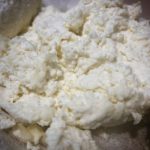Quick Cheese
A quick and easy first cheese recipe.
Materials
- 1 gallon milk use whatever kind of milk you'd like
- 1/2 cup white vinegar
- 1 tbsp salt optional
Instructions
- Warm the milk in a large heavy-bottomed pot, stirring continuously until it reaches 195F and then remove from heat. (We don't want any of the milk to scorch to the bottom, so be diligent about the stirring.)
- Pour in the vinegar and stir gently once or twice to ensure the acid is evenly mixed, but don't over stir and risk damaging the curds.
- Watch as the white curds start to develop and separate from the yellow whey. As they cool, the curds will get firmer, and stick to each other. This should take about five minutes.
- Carefully ladle the warm curds into a strainer lined with multiple layers of cheesecloth--resist the temptation to pour them from the pot into the strainer--it'll only damage the curds and those little pieces will clog the cheesecloth. Capture the whey in a bowl placed under the strainer. Once cool, you can drink it (it's delicious!), use it as extra flavour in soup stock or use it as plant food in your garden.
- Add salt at this point, if desired. You can also add other herbs or spices, if you'd like to experiment. If you add something, give it a gentle toss with a fork to spread your addition through the curds.)
- For queso fresco, gather the cheesecloth edges together and twist gently to give the cheese a little squeeze and let sit on a draining rack as the whey continues to drip out of the cheese. For paneer, take the cheese and place in a cheese mold with a weight on top to more firmly press the cheese. As soon as it's cold, it's ready to use!
- This cheese, in either form, will last about a week in the fridge. Unlike other cheese, paneer and queso fresco can also be frozen without much effect. Also, because of its firm texture, paneer can be fried without melting.
- Enjoy!
Notes
At its most basic, making cheese is simply the process of turning milk into something solid and tasty. There are many different ways to accomplish this, but they generally involve using some combination of acid, heat and enzymes. This simple and quick cheese recipe will use acid and heat to turn a gallon of store-bought milk into about a pound of something you could call "queso fresco" or "paneer".
This isn't a hard process, but you need to pay close attention to get the best results.
